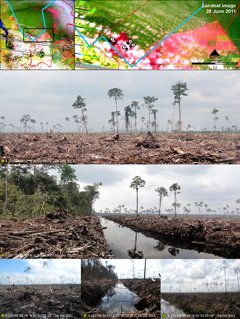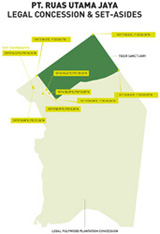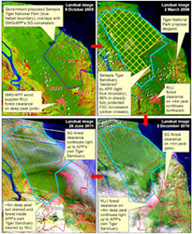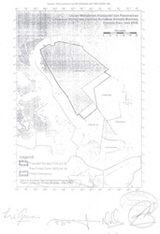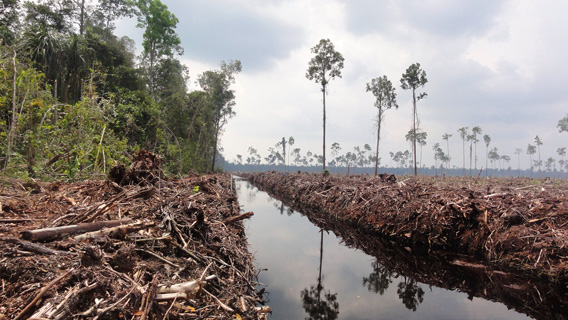
Peat draining and large-scale clearance of natural forest by APP wood supplier PT. Ruas Utama Jaya inside APP’s Senepis Tiger Sanctuary in June and October 2011. © Eyes on the Forest / WWF-Indonesia
Asia Pulp & Paper (APP) continues to mislead the public about its role in destroying rainforests and critical tiger habitat across the Indonesian island of Sumatra, alleges a new report from Eyes on the Forest, a coalition of Indonesian environmental groups including WWF-Indonesia. But APP is sharply contesting the claims.
The report, titled The truth behind APP’s Greenwash [PDF], is based on analysis of satellite imagery as well as public and private documentation of forest cleared by logging companies that supply APP, which is owned by the Indonesian conglomerate, Sinar Mas Group (SMG). The report concludes APP’s fiber suppliers have destroyed 2 million hectares of forest in Sumatra since 1984, including 675,000 ha of “critically endangered” and “endangered” forest, 550,000 ha of tiger habitat, 240,000 ha of elephant habitat, and 1,500 ha of orangutan habitat. It notes that APP concessions still threaten more than 300,000 ha of endangered forest.
Eyes on the Forest uses this data to debunk APP’s claimed commitment to conservation. APP has recently stepped up a campaign to market itself as a responsible steward of the environment that protects endangered tigers, elephants, rhinos, and orangutans.
“This is clear proof that the global advertising claims of APP that it actively protects Sumatran tiger are highly exaggerated”, Anwar Purwoto of WWF said in a statement.
The report alleges that a tiger sanctuary APP claims to have created is actually 86 percent owned by an unrelated company. It also says APP tried to block the creation of the proposed Senepis National Park, while one of its suppliers is currently clear-cutting the area of the sanctuary that represented APP’s “only real contribution” to tiger conservation.
“It’s appalling that APP is pulping even the small blocks of forest it had told the world it would protect as tiger habitat,” Hariansyah Usman of WALHI Riau said in a press release. “This report shows a different picture to this and other, much-touted APP ‘conservation projects.'”
However APP denied it cleared any forest within the Senepis Tiger Sanctuary.
“Senepis is exclusively a private sector partnership between APP and PT Diamond Raya providing the total land area of the sanctuary,” an APP spokesperson told mongabay.com. “The suggestion made by EoF/WWF that APP is clearing their contribution to the sanctuary is completely false and is substantiated by the official government maps.”
APP released a map showing the geo-referenced points cited in WWF’s report laying outside what APP said was its contribution to the tiger sanctuary.
“The government map which we have released today clearly shows that EOF’s pictures are from a legal pulpwood concession operated by one of our suppliers and not from inside the sanctuary,” said APP Managing Director Aida Greenbury in a statement.
But WWF quickly responded to APP’s map, providing mongabay.com a letter from June 2006 in which APP lays out its commitment to the “Senepis Tiger Sanctuary”.
“We used APP’s own ‘Proposed Senepis TCA Jun 06’ boundary in the map for our analysis, as the company’s public commitment to tiger conservation,” said WWF. “The boundaries, the only ones ever promulgated in public until APP’s riposte to our release… place the current clearing clearly within the boundaries signed off by APP in June 2006.”
“APP is not refuting that it has pulped the tiger forest of the original government-proposed Senepis National Park,” WWF added.
Peatlands, high conservation value forest conversion
Clearing in the tiger sanctuary wasn’t the only charge levied against APP in the report. The truth behind APP’s Greenwash says APP suppliers have cleared areas of “deep” peat in violation of Indonesian law as well felling trees in high conservation value forest areas.
“The company is knowingly and relentlessly destroying high quality tiger habitat,” WWF told mongabay.com. “APP has also broken its own HCVF protection promises in Kampar and Kerumutan.”
APP again disputed these accusations, stating that while its suppliers do clear peat areas deeper than 3 meters, this activity is not illegal.
“The Decree which regulates pulpwood plantation development actually says: ‘Criteria of peatland is land that contains peat with thickness deeper or equal to 3 meters that is located in upstream of river and swamp,'” APP told mongabay.com. “This has been clearly defined in the Government’s micro and macro-delineation principles.”
“As such, APP as well as its suppliers are held accountable to this standard, but as it is defined by the government of Indonesia’s macro and micro delineation principles, not by a Eyes on the Forest misquote of the guidelines.”
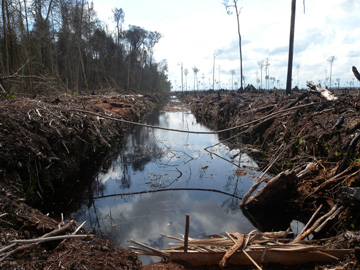 Peat draining and large-scale clearance of natural forest by APP wood supplier PT. Ruas Utama Jaya inside APP’s Senepis Tiger Sanctuary in June and October 2011. © Eyes on the Forest / WWF-Indonesia |
Yet two peat experts said that, at best, APP seems to be exploiting a loophole in regulations governing conversion of peat areas for plantations.
“The claim from APP that there conversion of peat deeper than 3 meters is legal because these peatlands are not lying upstream is of course total nonsense, as all lowland peatlands are rainwater fed and draining into the adjacent rivers, streams and sea. They are thus always and without exception upstream of their immediate surroundings,” said Marcel Silvius, a senior scientist at Wetlands International. “Following APP’s reasoning, only deep peatlands on the very top of Mount Kerinci would be protected.”
“APP seems to try to bend the Indonesian law to the extent that in the long term it may cause major harm to Indonesia’s national interests and in addition their activities will result in huge green house gas emissions that will contribute to climate change thus jeopardizing all future generations around the world.”
Jack Rieley, Honorary Professor of Geography at the University of Nottingham, agreed that APP’s defense rings hollow.
“Those of us who have worked on peatland in Indonesia for a long time believe that the 3m depth Presidential Decree is paramount and takes precedence over all other regulations but it contains the confusing phrase ‘located in upstream of river and swamp’. This seems to provide APP and other developers with an excuse to destroy this ecosystem,” Rieley told mongabay.com via email. “APP is making a play on words to suit its own ends while trying to make out it is complying with the law. Law enforcement is poor in Indonesia and APP is certainly not abiding by the spirit of it.”
Rieley also undercut APP’s claim that plantations established on peatlands sequester more carbon than natural forests.
“At present APP is trying hard, by paying local scientists from the Agriculture University in Bogor ((IPB), who have not published original research data, and using its own PR department and website, to discredit the large bulk of international, peer reviewed, scientific research that shows clearly that pulp tree plantations on peatland in Riau Province, Sumatra are releasing around 100 tonnes of CO2 per hectare every year,” he said.
APP says it is the first pulp and paper operator in Indonesia to commission carbon accounting of its operations. Aida Greenbury told mongabay.com that it is currently funding research that looks at emissions from its plantations, but suggested that plantations were “good” for peatlands.
Greenbury also said that APP does conduct required HCVF assessments and has protocols in place to ensure no protected timber species — including CITES-listed ramin — end up in its pulp mills.
“All of the mills are equipped with wood checking stations that require the registration of each inbound load of logs and the supplier delivering the shipment,” said APP. “At the wood checking station a manual inspection is conducted of the load to verify that there are no protected species that have been illegally harvested.”
Greenwashing charges
 Several of the revelations in The truth behind APP’s Greenwash have been presented previously in reports by Greenomics-Indonesia, Greenpeace, the Rainforest Alliance, and earlier work by Eyes on the Forest. |
The Eyes on the Forest report took direct aim at APP’s marketing tactics. It says APP has paid a range of “publicists, individuals and supposedly independent NGOs to flack its allegedly green practices.” These include, Cohn & Wolfe, a public relations firm; Environmental Resource Management, a consultancy; World Growth International and ITS Global, a lobby group for industrial forestry and a marketing firm both run by Alan Oxley; Mazars, an accounting and professional services giant; Carbon Conservation, a forest carbon project developer; Greenspirit Strategies, a marketing company run by Patrick Moore; the Sumatran Tiger Conservation Foundation (YPHS), a group represented as a conservation organization; and Allyn Media, a Texas-based branding firm that focuses on political campaigns. The reports notes that some of these entities have helped APP challenge criticism on issues including greenhouse gas emissions from its paper production, its role in deforestation, and compliance of its operations with Indonesian law. In the worst cases, groups paid by APP have launched campaigns against NGOs and companies that have dropped APP products due to environmental concerns.
“We would like the Sinar Mas Group’s buyers and investors who read this report to realize how APP’s media campaigns are exploiting their lack of knowledge or inexperience about Indonesia and how they mislead their customers about the brutal reality on the ground,” said Hariansyah WALHI Riau.
“APP is interested only in feeding its giant mills with as much tropical forest wood as possible, and hoping that customers and investors will continue to believe conservation commitments and advertisements which past experience shows to be unrealistic.”
The report notes that although APP has pledged to phasing out wood pulp produced from destruction of rainforests by 2015, it has missed three previous targets for the same commitment: 2004, 2007, and 2009. Eyes on the Forest expects APP to eventually renege on the 2015 promise.
“SMG/APP continues its large-scale natural forest destruction unabated,” states the report. “SMG/APP has repeatedly demonstrated that its ‘commitments’ to sustainability cannot be trusted.”
Related articles
